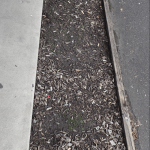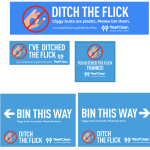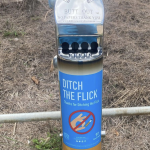Ditch The Flick QLD SRP (ReefClean)
Source Reduction Plan (SRP) Overview
Name of SRP
Partners Delivering the SRP
- Tangaroa Blue Foundation – Project lead of SRP, responsible for volunteer engagement, data collection and synthesis, project reporting.
- ReefClean: Supported and performed the auditing processes
- Local Councils
- Gladstone Regional Council
- Cairns Regional Council
- Townsville City Council
Location
- Gladstone: 2 locations on Goondoon Street
- Cairns: IGA Maroona
- Townsville: Walker Street
Photo 1
Evidence of the issue

Photo 2
Evidence of SRP resources

Photo 3
Evidence of positive outcomes

Overall Goals & Background
Targeted Debris
Cigarette Butts
Why is the SRP needed?
The Australian Marine Debris Initiative (AMDI) data shows cigarette butts are one of the top 10 items of litter found impacting the Great Barrier Reef and waterways across Australia and is always one of the top 10 items being found in clean-ups, particularly in urban areas.
Most people don’t want to deliberately pollute the environment, but many don’t realise that whilst the majority of a cigarette is ‘biodegradable’, cigarette filters are made of plastic and it is estimated to take 10 years to degrade into small plastic fibres and remnants.
This is a continuing issue within the marine environment, with particular focus on marine birds who mistake the debris as viable food for their offspring.
Overall Goals
Numerous campaigns in the past have attempted to shame smokers into quitting, without ever trying to help smokers better understand the environmental impacts of their habit. The project was specifically aimed to draw attention to the habitual action and impact of flicking a cigarette butt, hence the name ‘Ditch the Flick’.
To help achieve our goal we deployed the following tactics:
By using data from the AMDI database, we were able to identify hotspots in which heavy cigarette butt litter was collected and after conducting site visits we chose 3 locations to implement this campaign.
Along with the identification of legally acceptable areas for smoking in line with current state tobacco laws, Tangaroa Blue Foundation reviewed pre-existing Designated Smoking Areas (DOSA’s) and assessed and suggested new DOSA locations to local councils, venues and various major social events.
Tangaroa Blue Foundation worked closely with the local Councils, Port Douglas, Gladstone, Cairns, Rockhampton and Townsville, to create co-branded specialised butt bins and directional signage to encourage visitors to dispose of their cigarette litter appropriately.
To attain realistic results we designed, printed and distributed directional signage and audited these areas both before and after implementation. As this SRP is focused around behavioural changes, following implementation this is not time bound and ongoing.
Logistics
Timeline and Project Goals
General Timeline: 2 months
Audits: From 22 May – 20 June 2021 weekly
- Gladstone – 5
- Cairns IGA- 3
- Townsville – 3
Measuring Success
Once the specialised butt bins were installed within DOSA’s, the Tangaroa Blue Foundation and our ReefClean Litter Hero teams conducted debris audits and observational studies to determine the success of their location. By collecting the contents of the cigarette butt bins and performing cleanups within the area, we could measure the effectiveness of this SRP.
Assets:
- Specialised butt bins with graphics
- UV Stable directional stickers
- UV Stable co-branded stickers
- Fact Sheet
- Ditch the Flick directional A-frame corflute signs
- Ditch the Flick smoking area A-frame corflute signs
- Social Media banners and photos
- Ditch the Flick flags
To grab the attention of our smoking targeted audience, we used brightly coloured, engaging and noticeable prints across all assets and campaign promotion. We created a landing page reefclean.org/ditchtheflick with free downloadable campaign assets and information directed at venues to download and display signage.
Both Tangaroa Blue Foundation and Reefclean ran a huge social media promotion to generate awareness around the campaign. Once analysed we could see how many views and downloads were made on the website and our media posts.
To grab the attention of our smoking targeted audience, we used brightly coloured, engaging and noticeable prints across all assets and campaign promotion.
We created free downloadable campaign assets and information directed at venues to download and display signage.
Both Tangaroa Blue Foundation and Sustainability Victoria ran social media promotions to generate awareness around the campaign. Once analysed we could see how many views and downloads were made on the website and our media posts.
Data Collection & Reporting
The on the ground transect method was used to identify cigarette butt litter hotspots, potential signage and collection points/locations.
Data was pre and post audited by the number of cigarette butts in butt bins from 22 May 2021 and 20 June 2021 (Before and after the sticker campaign was implemented). This was then entered into the Australian Marine Debris Initiative (AMDI) Database for analysis and result comparisons.
Results and Reflections
Positive Outcomes
During the campaign period, there was a noticeable reduction in cigarette butt litter in Gladstone. The colourful UV stable stickers were received well by the local community. Five audits were conducted in Gladstone at two cigarette butt litter hotspots on Goondoon Street. The initial campaign audit on 29 May recorded 1,000 butts but the number rapidly decreased to just 80 a week later. The trend continued over the month with 48 butts recorded on 18 June, 22 butts on 22 June and just 11 butts by the final audit on 25 June. 50 portable butt bins were distributed across two local pubs, the Gladstone Reef Hotel and the Light Box, they were given 25 bins each.
Three audits were completed at the IGA Manoora in Cairns. The IGA is located in a large shopping area that includes many small businesses, as well as outdoor eating and smoking areas. Although the areas are supposed to be separate, the signage is not clear enough for a casual shopper to observe, so they have tended to merge. Ditch the Flick stickers were placed in both areas on the 11th of June, but were later found to have been removed from some of the tables in the food areas which may have impacted the effectiveness of the campaign.
The campaign also went very well in Townsville, which also saw a sizable decrease in cigarette butt litter. Three audits were conducted in Townsville at cigarette butt hotspots along Walker Street. Earlier audits had established on average 279.5 butts were littered each week. The initial campaign audit on 11 June recorded 629 butts, with the number decreasing to 131 a week later (18 June) and to just 123 butts by the final audit on 15 June. Compared to the weekly average there was approximately a 56% decrease in butts being littered in the final week of the campaign.
Media:
Social media engagements across Facebook and Instagram with 7 posts reaching 418 people and 3 Website Articles:
https://www.tangaroablue.org/amdi-network/reefclean/ditchtheflick/
https://www.tangaroablue.org/reefclean-news/trigger-of-the-butt/
A volunteer recruitment poster was sent out to a Townsville volunteer mailing list of 84 recipients, posted on ReefClean social media platforms and also was included in the North Queensland Conservation Council’s monthly e-newsletter which is distributed to 1400 recipients.
Funding
Overall Cost: $7,775.96
Assets: Campaign specialist – $4670, Printing- $110,
Community: Volunteer Hours – 2,670
Challenges & Improvements
Gaining council approval for the directional signage in some locations slowed the delivery of the campaign but once achieved, the campaigns proved successful.
In Cairns, the set up of the space audited limited the effectiveness the campaign could have, as well as the issue of people removing our stickers.
Future Opportunities
There is a huge opportunity to expand the ‘Ditch The Flick’ campaign in other cigarette butt hotspots within urban and coastal areas within the Great Barrier Reef surroundings.
Once implemented the stickers and signage remain in place hopefully continuously reminding and engaging smokers to dispose of their cigarette butts correctly.
Within the workshop there were discussions around times when butt bins are not available for smokers. This led to the idea of providing personal butt bins as an effective tactic for reducing litter.

